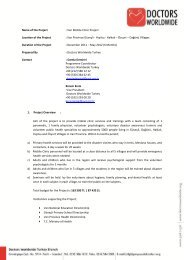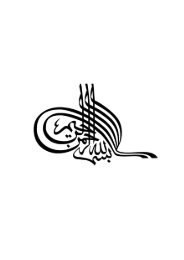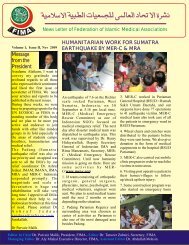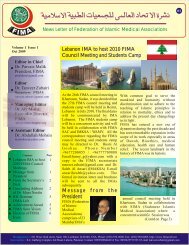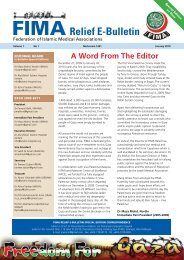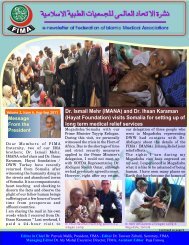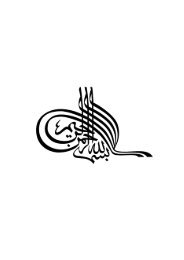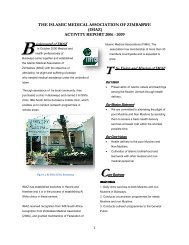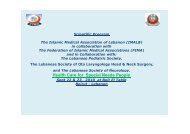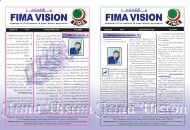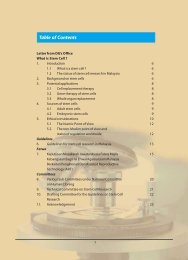FIMA Year Book 2009 - Federation of Islamic Medical Associations
FIMA Year Book 2009 - Federation of Islamic Medical Associations
FIMA Year Book 2009 - Federation of Islamic Medical Associations
You also want an ePaper? Increase the reach of your titles
YUMPU automatically turns print PDFs into web optimized ePapers that Google loves.
Inculcating <strong>Islamic</strong> Inputmore strategies in order to achieve athorough and complete model <strong>Islamic</strong>medical curriculum at CUCMS.Recommendations on <strong>Islamic</strong> input inpre-clinical medical curriculum:1. Introducing `Spiritual History` takingfrom the first year: Performing aspiritual history facilitates the practice <strong>of</strong>compassion with one’s patients, and helpsthe clinician learn to integrate spiritualityinto the therapeutic plans (52) . AppendixB shows some models <strong>of</strong> spiritual historytaking developed and used in someinstitutions (53-55) .A study was conducted to evaluate the impact<strong>of</strong> a spiritual history-taking curriculum onthe skills, knowledge, and attitudes <strong>of</strong> 1styear medical students (56)The results showed slightly improved abilityin recognizing the patient’s spiritual concernsand in accommodating the patients’ beliefs.The researchers concluded that “spiritualhistory taking can be integrated effectivelyinto the existing history-taking curriculumin first year <strong>of</strong> medical training”.Another study concluded that studentsexposed to material on spirituality inmedicine have shown greater understanding<strong>of</strong> the issue but no difference in clinicalperformance (57) .2. Maximum exposure to knowledge:Students should not be asked to limit theirknowledge only to the `must know` topics,instead they should be encouraged to obtainas much information about a subject ortopic as possible in order to enhance theirunderstanding and lateral thinking skills.3. Students should be advised to use propertechniques to gain attention: i.e. sub-vocalrepetition <strong>of</strong> presented material.4. Motor system involvement to enhancememory and retention: Writing ordrawing are crucial memory enhancingtools as they incorporate the motor systemin the learning process.5. Large class lectures: to introduce topicsrelated to philosophy <strong>of</strong> <strong>Islamic</strong> medicine.For example, introducing revelation asa prime source <strong>of</strong> knowledge, as Islampointed out the scientific truths <strong>of</strong> anatomy,physiology, biochemistry, etc. centuries agobut were only known by modern sciencecenturies later through decades <strong>of</strong> trials,errors and experiments6. Introducing the `Life <strong>of</strong> ProphetMuhammad (PBUH) ` as role model:Students should be exposed to `Sunnah`and `Hadith` in order to develop anappropriate attitude and behaviour(Affective Domain).7. Teaching prayers (Duaa) and Names <strong>of</strong>Allah ( al-Asma-al-Husna): Studentsshould learn and memorize some prayersfrom the Qur’an and Sunnah and the namesand the meanings <strong>of</strong> the names <strong>of</strong> Allahand His attributes, to be a helpful source <strong>of</strong>guidance to patients.8. Evidence-Based Medicine (EBM) andResearch methods: EBM and researchshould be encouraged from the verybeginning <strong>of</strong> training.9. Complimentary and Alternative Medicine(CAM): CAM should be introduced fromthe beginning to help students in studyingcomparative medicine. Stress should begiven to <strong>Islamic</strong> methods i.e. prayers,plants and herbs, honey and cupping (al-Hijamah).10. Personal and Pr<strong>of</strong>essional Development(PPD): Students should be encouragedto develop themselves as pious Muslims,life-long learners and competent and kindphysicians.<strong>FIMA</strong> <strong>Year</strong><strong>Book</strong> <strong>2009</strong>41




